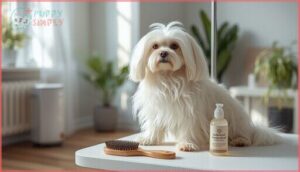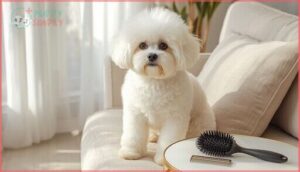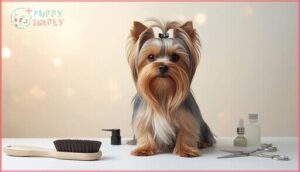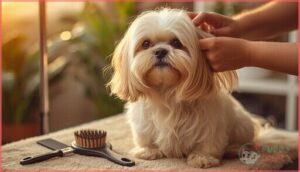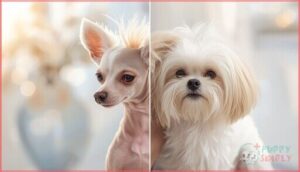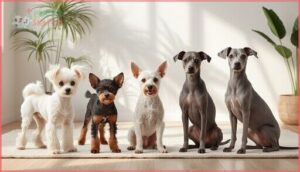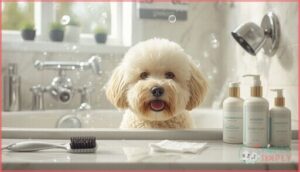This site is supported by our readers. We may earn a commission, at no cost to you, if you purchase through links.
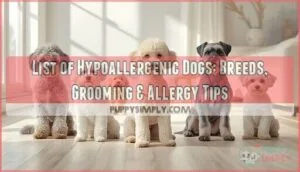
Low-shedding breeds trap these particles in their coats rather than releasing them into your home’s air, reducing airborne allergens by up to 60%. Understanding which breeds produce less dander and how to manage allergen exposure can mean the difference between a life with or without a canine companion.
From compact Maltese to standard Poodles, certain breeds combine reduced shedding with manageable grooming needs, offering realistic options for allergy-sensitive households.
Table Of Contents
- Key Takeaways
- What Makes a Dog Hypoallergenic?
- Popular Small Hypoallergenic Dog Breeds
- Best Medium and Large Hypoallergenic Dogs
- Unique Hypoallergenic and Hybrid Breeds
- Essential Grooming and Allergy Management Tips
- Frequently Asked Questions (FAQs)
- Are there any 100% hypoallergenic dogs?
- How can I find a responsible breeder for a hypoallergenic puppy?
- What kinds of grooming do hypoallergenic dogs require?
- How much exercise do hypoallergenic dogs need each day?
- What health issues are common in hypoallergenic breeds?
- Are hypoallergenic dogs safe for severe allergies?
- Do hypoallergenic puppies cost more than others?
- Which hypoallergenic breed needs least exercise daily?
- Can hypoallergenic dogs live in small apartments?
- Do all hypoallergenic breeds get along with cats?
- Conclusion
Key Takeaways
- No dog breed is truly hypoallergenic—all dogs produce allergens (Can f 1 through Can f 7) in their dander, saliva, and urine, regardless of coat type or shedding patterns.
- Low-shedding breeds like Poodles, Maltese, and Bichon Frises trap dander in their curly or wiry coats rather than releasing it airborne, reducing environmental allergen loads by up to 60% compared to double-coated dogs.
- Effective allergy management requires combining breed selection with consistent grooming (daily brushing, bathing every 2-4 weeks, professional grooming every 4-6 weeks) and home strategies like HEPA filtration and pet-free bedroom zones to cut allergen levels by up to 90%.
- Individual allergen sensitivity varies widely even within the same breed, so spending extended time with your chosen dog before adoption is essential to assess your specific immune response.
What Makes a Dog Hypoallergenic?
You’ve probably heard the term “hypoallergenic dog” tossed around when people talk about breeds that won’t trigger their allergies. But what does that really mean, and can any dog truly be allergen-free?
Let’s break down the science behind low-shedding coats, how dogs actually produce allergens, and clear up some common myths that might be steering you in the wrong direction.
Low-Shedding Coats and Dander
Low-shedding coats trap dander within their curly or wiry structure, reducing airborne allergy triggers. Breeds like Poodles and Bichon Frises shed less than five grams monthly—compared to over forty grams in double-coated dogs—thanks to hair follicle genetics that limit shedding rates.
Their coat structure provides allergen trapping, decreasing environmental allergen loads by up to 60%, though no breed is truly non-shedding. Understanding low shedding breeds is essential for managing allergies and choosing the right pet.
Allergen Production in Dogs
Dogs produce seven main canine allergens—Can f 1 through Can f 7—in their dander, saliva, and urine, not just their coats. Can f 1 affects 50% of allergic individuals, while Can f 5 impacts 70%.
Dogs produce seven allergens in dander, saliva, and urine—not just their coats—with Can f 5 affecting 70% of allergic individuals
Even hypoallergenic dog breeds with nonshedding coats generate these molecular factors at similar levels to other dogs. Allergen variability between individuals of the same breed means breed sensitization patterns don’t guarantee reduced allergy triggers for you.
Understanding dog allergy causes is essential for managing allergies effectively.
Common Misconceptions About Hypoallergenic Breeds
Many pet allergies stem from allergen myths perpetuated by breed marketing. You may believe hypoallergenic dog breeds eliminate reactions, but here’s what studies show:
- Nonshedding dog breeds and lowshedding dog breeds produce equal allergen levels in household dust compared to other breeds
- Poodle mixes aren’t guaranteed hypoallergenic—genetics don’t prevent dog dander production
- Dog allergies affect people regardless of breed size or coat length
No breed offers complete allergy prevention through allergy management alone.
Popular Small Hypoallergenic Dog Breeds
If you’re looking for a compact companion that won’t leave you sneezing, small hypoallergenic breeds offer some of the best options. These dogs usually weigh under 20 pounds and produce less dander than their larger counterparts, making them ideal for apartment living or anyone with limited space.
Let’s look at six popular small breeds that combine manageable size with low-shedding coats.
Maltese
You’re looking at a breed that checks many boxes for allergy-sensitive households. Maltese dogs weigh just 4–8 pounds and stand 7–12 inches tall, with a single coat that sheds minimally. Although they’re not allergen-free—dander, saliva, and urine still contain proteins—their low-shedding coat limits allergen spread compared to double-coated breeds.
| Feature | Specification | Allergy Benefit |
|---|---|---|
| Weight | 4–8 pounds | Smaller body surface produces less dander overall |
| Coat Type | Single-layer hair | Minimal shedding limits airborne allergen distribution |
| Grooming | Daily brushing, bath every 1–2 weeks | Regular maintenance traps dander before release |
| AKC Status | Listed for allergy sufferers | Lower dander production compared to double-coated breeds |
Daily brushing prevents matting and captures loose dander before it becomes airborne. Bathing every one to two weeks further reduces allergen load.
If you’re managing dog allergies, Maltese rank among the most suitable low-shedding dog breeds—but remember, individual reactions vary based on your unique sensitivity to canine health proteins.
Bichon Frise
Bichon Frise dogs trap dander in their woolly coats instead of releasing it, which is why they’re among the most recommended hypoallergenic dogs for allergy-sensitive homes. These low-shedding dog breeds weigh 12–18 pounds and measure 9–11 inches tall, with a 14–15 year lifespan.
To minimize dog allergies, follow these grooming tips:
- Brush daily to prevent matting
- Schedule professional grooming every 4–6 weeks
- Bathe regularly to reduce allergen load
Though no non-shedding dog breeds are truly allergen-free, Bichon Training and proper Frise Nutrition support coat health. Their Breed History as companion animals makes Dog Socialization second nature.
Shih Tzu
Shih Tzu health requires honesty: these dogs aren’t truly hypoallergenic. Their double-layered, hair-like coat sheds less than many breeds, but allergens still exist in skin, saliva, and urine, regardless of grooming. You’ll need regular brushing and dog training patience to manage dander.
| Characteristic | Allergy Impact |
|---|---|
| Coat type | Hair-like, not fur |
| Shedding level | Lower than average |
| Allergen production | Present in all specimens |
| Grooming frequency | Daily brushing needed |
Pet nutrition and breed history don’t eliminate allergic responses—individual reactions vary widely.
Yorkshire Terrier
Yorkshire Terrier coats grow continuously like human hair, reducing loose dander compared to fur-bearing breeds. You’ll find Yorkies aren’t completely hypoallergenic—allergens persist in skin and saliva—but their minimal shedding offers advantages for sensitive owners.
- Weight ranges 4–7 pounds in this small breed
- Professional dog grooming needs arise every few months
- Yorkie training benefits from consistent pet care routines
- Terrier health requires monitoring for crossbreed allergenicity variations
- Dog nutrition promotes coat quality in lowshedding dog breeds
Havanese
Havanese behavior includes forming close family bonds, while their silky, continuously growing coat places them firmly among nonshedding dog breeds. Weighing 7–13 pounds with a 14–16 year lifespan, these hypoallergenic dogs reduce dander exposure—though you’ll still need consistent Havanese grooming to prevent matting.
Havanese care involves daily brushing, and Havanese training responds well to positive reinforcement.
Havanese nutrition and Havanese health monitoring support their low-shedding coat quality and dog grooming needs.
Chinese Crested
Chinese Crested hypoallergenic traits differ dramatically between the hairless and powderpuff varieties, with hairless versions producing less dander while still requiring crested care for exposed skin. These nonshedding dog breeds with Chinese origins offer three distinct advantages for allergy-sensitive households:
- Minimal coat maintenance for hairless types
- Reduced allergen spread compared to fully coated breeds
- Individual allergen responses vary by variety
Powderpuff grooming demands daily brushing, while no hypoallergenic dogs remain 100% allergen-free regardless of their lowshedding dog breeds classification.
Best Medium and Large Hypoallergenic Dogs
If you’re looking for a bigger companion that won’t send your allergies into overdrive, you’ve got some solid options. Medium and large hypoallergenic breeds combine low-shedding coats with the energy and presence many families want.
Here are seven breeds that fit the bill for allergy-conscious households seeking a larger dog.
Poodle (Standard and Miniature)
Poodles—whether Standard or Miniature—shed less than most breeds, thanks to their low-shedding coats that trap dander instead of releasing it into your home. This trait, combined with their popularity among nonshedding dog breeds, makes Poodle training and grooming needs essential topics.
You’ll need professional grooming every 6-8 weeks, and proper Poodle nutrition helps prevent health issues, ensuring these hypoallergenic dogs stay healthy throughout their 10-18 year lifespan.
Portuguese Water Dog
If you’re looking for a larger hypoallergenic companion, the Portuguese Water Dog offers curly coat care that traps dander effectively. This breed weighs 35-60 pounds and stands 17-23 inches tall, with breed history rooted in maritime work.
You’ll need weekly brushing and regular Portuguese grooming to prevent matting. Water dog training accommodates their high-energy temperament, and their minimal shedding made them the Obama family’s choice for hypoallergenic benefits.
Soft Coated Wheaten Terrier
For allergy sufferers seeking medium-sized terriers, Soft Coated Wheaten Terriers produce less dander through their single, wavy coat.
You’ll find this breed weighs 30-40 pounds and stands 17-19 inches tall, with a breed history spanning over 200 years as Irish farm dogs.
Weekly coat maintenance prevents tangling and allergen buildup. Their affectionate temperament suits families, though terrier training manages their energetic nature effectively.
Standard Schnauzer
Standard Schnauzers offer wiry, low-shedding coats that trap dander before it spreads through your home. You’ll appreciate their 35-50 pound weight range and trainable temperament, making them protective family pets.
- Grooming needs: Professional trimming every 6-8 weeks controls allergen buildup
- Breed history: German farm dogs valued for versatility and hypoallergenic qualities
- Health issues: Generally sturdy, with 12-15 year lifespans when properly maintained
Afghan Hound
Afghan Hounds require daily brushing to maintain their silky, flowing coats, but don’t let that deter you—they produce minimal dander, making them suitable for allergy-prone households. At 25-27 inches tall and 50-60 pounds, these elegant dogs live 12-18 years.
Dog allergy tests before adoption help confirm compatibility. Their training needs include patience with their independent nature, while Afghan Hound grooming demands consistent attention for best allergen control.
Irish Water Spaniel
You’ll find the tallest spaniel breed in the Irish Water Spaniel, standing 21-24 inches and weighing 45-68 pounds. Their curly, water-resistant coats make them excellent hypoallergenic dogs for allergy sufferers, shedding minimally when maintained properly.
Irish grooming demands weekly to biweekly attention to enhance these low-shedding dog breeds’ allergen control.
With 12-13 year lifespans, breed history shows they’ve excelled in water work and active family settings requiring consistent dog training.
Basenji
Unique among hypoallergenic dogs, the Basenji produces minimal dander due to its short, fine coat and self-grooming habits. Breed characteristics include a barkless vocalization and a height of 16-17 inches.
Exercise needs demand daily activity, while the Basenji’s history traces back to African hunting dogs.
Training tips emphasize patience with their independent nature. Health issues can include eye conditions, making regular veterinary monitoring essential for dog allergy management.
Unique Hypoallergenic and Hybrid Breeds
Some hypoallergenic breeds stand out for their distinct appearance or unique background. These dogs range from compact terriers with wiry coats to rare hairless breeds that originated centuries ago.
Each offers something different for people managing allergies while seeking a companion with character.
Miniature Schnauzer
Miniature Schnauzers rank among popular hypoallergenic dogs and nonshedding dog breeds, thanks to their double coat that sheds minimally. While no breed eliminates dog allergies entirely, these low-shedding dog breeds reduce airborne dander. Pet ownership with a Miniature Schnauzer requires consistent attention to grooming needs and Schnauzer health:
- Professional grooming every 4–6 weeks maintains coat quality and limits allergen buildup
- Brush two to three times weekly to prevent matting
- Monthly baths decrease dander on your dog’s skin
Scottish Terrier
Scottish Terriers stand out among low-shedding dog breeds, releasing fewer allergens than many dogs but never fully eliminating dog allergies. Their wiry coat requires brushing daily and professional dog grooming every six to eight weeks to manage dander on skin and saliva.
Terrier health depends on consistent pet grooming, yet you’ll still find proteins in urine that trigger reactions in sensitive individuals despite these hypoallergenic dogs’ favorable breed characteristics.
Whoodle
Whoodles combine the Soft Coated Wheaten Terrier’s silky texture with the Poodle’s minimal shedding, creating one of the most popular hybrid dog breeds for allergy-sensitive households. Their wavy coat reduces airborne dander, making them a great choice for those with allergies.
You’ll need to brush your Whoodle three to four times weekly and schedule professional dog grooming every six to eight weeks to maintain their coat. Proper Whoodle training and dog socialization are also essential for their well-being.
In addition to grooming and training, balanced canine nutrition supports overall hybrid health throughout their 12 to 15-year lifespan.
Xoloitzcuintli (Mexican Hairless Dog)
The Xoloitzcuintli, one of the oldest hairless dogs with Mexican origins, produces minimal dander compared to coated breeds. However, you’ll still need consistent Xolo care focused on skin health.
Bathe your Xoloitzcuintli every two to four weeks using hypoallergenic shampoo, followed by moisturizer to prevent dryness. This hairless grooming routine helps manage allergens effectively, making nonshedding dog breeds like this excellent for dog allergy management in sensitive households.
Essential Grooming and Allergy Management Tips
Keeping a hypoallergenic dog comfortable and your home allergen-free takes consistent effort, but it doesn’t have to be complicated. The right grooming routine can greatly reduce dander and allergen levels in your living space.
Here are the key practices that make the biggest difference in managing allergens while keeping your dog’s coat healthy.
Daily Brushing and Coat Maintenance
You’ll want to brush your hypoallergenic dog daily to keep allergen buildup at bay. This simple routine removes loose fur and dander before they settle into your home, cutting indoor allergen levels by up to 84%.
Choose soft-bristle brushes for delicate skin, and use stainless steel combs for tangles. Daily brushing also distributes natural skin oils, supporting healthier coat condition between grooming appointments.
Professional Grooming Schedules
Beyond daily brushing, your hypoallergenic dog needs professional grooming every 4 to 6 weeks to maintain best coat condition and minimize allergen buildup. Poodles, Maltese, and similar breeds benefit most from regular sessions.
Expect costs between $50 and $90 per visit, depending on breed size and coat complexity. Full-service packages generally include bathing, trimming, nail care, and ear cleaning—all critical for controlling dander between appointments.
Bathing and Skin Care
Bathing frequency matters more than you might think. Wash your hypoallergenic dog at least twice weekly to cut recoverable allergen levels on skin and coat.
Use hypoallergenic shampoos for sensitive skin, and consider medicated options if your dog has allergic skin conditions. Keep water warm, not hot, to protect skin hydration.
Towel dry gently to avoid transepidermal water loss and irritation.
Allergen Reduction Strategies at Home
Your grooming routine only goes so far. The real work happens inside your home, where Can f 1 allergen particles settle and circulate for months.
- Install HEPA filtration systems to capture 99.95% of airborne dander particles.
- Vacuum weekly with HEPA-equipped cleaners on all surfaces.
- Restrict access to bedrooms, cutting airborne allergen levels by 90%.
- Control ventilation and humidity between 30–50% to limit allergen persistence.
- Choose leather or synthetic fabrics over porous upholstery for furniture.
Frequently Asked Questions (FAQs)
Are there any 100% hypoallergenic dogs?
You’ve probably heard promises of allergen-free breeds, but here’s the reality: no dog is 100% hypoallergenic.
All dogs produce Can f 1 allergens through skin, saliva, and urine—regardless of coat type or shedding.
How can I find a responsible breeder for a hypoallergenic puppy?
You’ll want to verify genetic testing records for breed-specific conditions, visit their facility to check cleanliness, meet the parents, review health guarantees carefully, and watch for breeder red flags like multiple-breed operations.
What kinds of grooming do hypoallergenic dogs require?
Think of a dog’s coat like a filter that needs regular cleaning.
Your hypoallergenic breed requires brushing two to three times weekly, bathing every 2-4 weeks, and professional grooming every 4-6 weeks to minimize allergens.
How much exercise do hypoallergenic dogs need each day?
Most hypoallergenic dogs need 30 to 60 minutes of daily exercise, adjusted for breed-specific needs, age considerations, and exercise intensity. Include walks, mental stimulation, and indoor activities for best health.
What health issues are common in hypoallergenic breeds?
You’ll find that genetic predispositions affect many hypoallergenic dog breeds. These include autoimmune disorders in Standard Poodles, breed-specific cancers in larger dogs, joint dysplasia, respiratory issues in brachycephalic types, and dental disease in smaller breeds.
Are hypoallergenic dogs safe for severe allergies?
About 10% to 20% of allergy sufferers still react to hypoallergenic dogs. Even minimal dog dander exposure can trigger severe responses in highly sensitive individuals, so consult an allergist before bringing home any breed.
Do hypoallergenic puppies cost more than others?
Yes, you’ll usually pay 50-100% more for hypoallergenic dog breeds. Breeder reputation, health testing, lineage verification, breed rarity, and demand factors drive these higher prices compared to non-hypoallergenic breeds.
Which hypoallergenic breed needs least exercise daily?
Among toy dog breeds, Chinese Crested and Maltese require minimal activity at just 20-30 minutes daily.
These low-energy breeds suit apartment living well, particularly for senior dogs or owners with exercise limitations seeking hypoallergenic dogs.
Can hypoallergenic dogs live in small apartments?
Most hypoallergenic dogs thrive in small apartments. Breeds weighing under 25 pounds adapt well to confined spaces.
You’ll need daily brushing, regular grooming every 4-8 weeks, and consistent allergen control methods to minimize dander effectively.
Do all hypoallergenic breeds get along with cats?
Breed compatibility with cats depends on temperament factors and prey drive, not hypoallergenic traits.
Most dog breeds coexist peacefully with proper socialization and training methods, making early exposure essential for family pets.
Conclusion
Finding the right fit from a list of hypoallergenic dogs requires matching breed characteristics to your lifestyle and allergy severity. Low-shedding coats reduce airborne dander, but no breed eliminates allergens completely.
Regular grooming, HEPA filtration, and designated pet-free zones create manageable environments for sensitive households. Before committing, spend extended time with your chosen breed to assess individual reactions.
The right combination of breed selection and environmental control transforms allergy management from obstacle into achievable reality, making canine companionship accessible for millions of allergy-affected families.
- https://www.metlifepetinsurance.com/blog/breed-spotlights/hypoallergenic-dogs-breeds-good-for-people-with-allergies/
- https://www.petmd.com/dog/general-health/hypoallergenic-dogs
- https://pmc.ncbi.nlm.nih.gov/articles/PMC8724828/
- https://spcala.com/study-suggests-no-such-thing-as-a-hypoallergenic-dog/
- https://www.aaaai.org/tools-for-the-public/conditions-library/allergies/dog-myths

